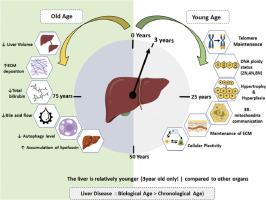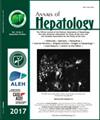肝脏对衰老过程有抵抗力吗?
IF 3.7
3区 医学
Q2 GASTROENTEROLOGY & HEPATOLOGY
引用次数: 0
摘要
肝脏具有独特的再生能力、免疫耐受特性和多倍体状态,是人体中与众不同的代谢器官。尽管肝脏已经衰老,但与其他器官(如肾脏)相比,肝脏一般很少出现病理异常,其功能接近正常的平衡状态。随着年龄的增长,肝脏可能会发生一些微妙的变化,包括血流量减少、解毒功能改变、假性毛细血管扩张和脂褐素沉积。研究表明,经过精心挑选的八旬高龄捐献者的肝脏移植后表现良好,这说明年龄并不一定会影响肝功能。值得注意的是,最近的一份报告表明,肝脏是一个年轻的器官,肝细胞的平均年龄仅为3岁。尽管肝脏的再生能力和细胞储备令人印象深刻,但一个挥之不去的问题依然存在:在整个机体按时间顺序衰老的过程中,肝脏是如何保持其年轻特性的?各种适应机制可能包括:(a) 细胞肥大,以在增殖开始前维持生理能力;(b) "倍性输送器 "作为一种基因适应,以承受与衰老相关的压力;(c) 端粒长度的持续,表明年轻;(d) 细胞外基质的积极重塑,以维持正常的细胞功能;(e) 基于线粒体-内质网的代谢适应;(c) 细胞可塑性作为健康衰老的适应机制。然而,必须注意的是,老年肝脏的再生能力可能会受到影响,慢性肝病往往与肝细胞过早衰老导致的功能下降有关。这篇综述深入探讨了随着年龄增长维持肝脏稳态的各种细胞适应性,并简要探讨了肝细胞加速衰老作为慢性肝病前兆的作用。本文章由计算机程序翻译,如有差异,请以英文原文为准。

Is the liver resilient to the process of ageing?
The liver's unique regenerative capacity, immunotolerant feature, and polyploidy status distinguish it as a metabolic organ unlike any other in the body. Despite aging, the liver generally exhibits fewer pathological abnormalities than other organs (such as the kidney), maintaining its functions near-normal balanced manner. Subtle changes in the liver, including reduced blood flow, detoxification alterations, pseudo-capillarization, and lipofuscin deposition, may occur with chronological age. Research indicates that carefully selected liver grafts from octogenarian donors can perform well post-transplant, emphasizing instances where age doesn't necessarily compromise liver function. Notably, a recent report suggests that the liver is a youthful organ, with hepatocytes averaging an age of only 3 years.
Despite the liver's impressive regenerative capabilities and cellular reserve, a lingering question persists: how does the liver maintain its youthful characteristic amidst the chronological aging of the entire organism? The various adaptive mechanism possibly include:(a) cellular hypertrophy to maintain physiological capacity even before proliferation initiates, (b) the "ploidy conveyor" as a genetic adaptation to endure aging-related stress, (c) sustained telomere length indicative of youthfulness (d) active extracellular matrix remodelling for normal cellular functioning, (e) Mitochondria-Endoplasmic Reticulum based metabolic adaptation and (c) cellular plasticity as fitness mechanisms for healthy aging. However, it is crucial to note that aged livers may have compromised regenerative capacity and chronic liver disease is often associated with declining function due to premature hepatocyte senescence. This review delves into varied cellular adaptations sustaining liver homeostasis with chronological aging and briefly explores the role of accelerated hepatocyte aging as a precursor to chronic liver disease.
求助全文
通过发布文献求助,成功后即可免费获取论文全文。
去求助
来源期刊

Annals of hepatology
医学-胃肠肝病学
CiteScore
7.90
自引率
2.60%
发文量
183
审稿时长
4-8 weeks
期刊介绍:
Annals of Hepatology publishes original research on the biology and diseases of the liver in both humans and experimental models. Contributions may be submitted as regular articles. The journal also publishes concise reviews of both basic and clinical topics.
 求助内容:
求助内容: 应助结果提醒方式:
应助结果提醒方式:


